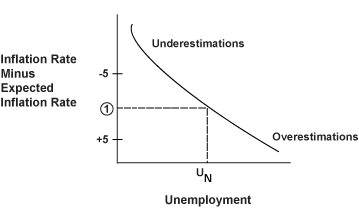Tradeoffs Between Unemployment and Inflation (the Phillips Curve)
The Phillips curve depicts an inverse relationship between inflation and the rate of unemployment. In other words, higher rates of inflation imply lower rates of unemployment. The relationship is named after the British economist A.W. Phillips, who wrote an influential article about it.
That inverse relationship held true during the 1960s. During the 1970s, however, the
Unexpected rises in the inflation rate decrease the "real" wages of workers operating under long-term employment contracts. This stimulates employment as real-wage costs to employers are reduced. Underestimates of inflation induce job seekers to take job offers they may not otherwise take. The job offer given may seem very good (if inflation is not taken into account) and it will be quickly taken. A worker who understands that inflation is eroding his or her real wages would not be so quick to take the job offer.
Once works begins to anticipate inflation, there is no long-term reduction in the unemployment rate. In the short-term, if inflation is higher than expected, there will temporarily be a reduction in unemployment. If inflation is lower than expected, unemployment will be higher than normal.
Figure 4.5: Modern Phillips Curve with Expectations
 |
In the graph above, Un is the natural rate of unemployment.
When integrating expectations and the Phillips curve, we find that:
- Expansionary fiscal and monetary policy leads to inflation, without a permanent reduction in unemployment below the natural rate.
- If inflation is greater (less) than anticipated, unemployment will be below (above) the natural unemployment rate
- If the inflation rate remains the same (does not increase or decrease), then the actual rate of unemployment will move towards the natural rate of unemployment.
The following lessons were learned from the work with Phillips curves:
- Expansionary macro policy does not reduce the rate of unemployment, at least in the long run.
- Stable prices help keep unemployment low - stable prices are low unemployment are not conflicting goals.
Impacts of Inflation on the Nominal Interest Rate
The nominal interest rate of a bond or loan is simply the stated or named interest rate. The real interest rate is the nominal interest less current or expected inflation.
If economic participants expect higher inflation, they will alter their economic behavior. Lenders will be less willing to make loans or will demand higher nominal rates of interest in order to compensate for the perceived risk of inflation. Borrowers will seek more loanable funds in anticipation of higher prices. The net result will be higher nominal interest rates.
Increases in the money supply will lead to higher price levels, unless there is a corresponding increase in real output. Lenders will demand higher nominal interest rates so as to compensate for the expected inflation.






0 comments:
Post a Comment